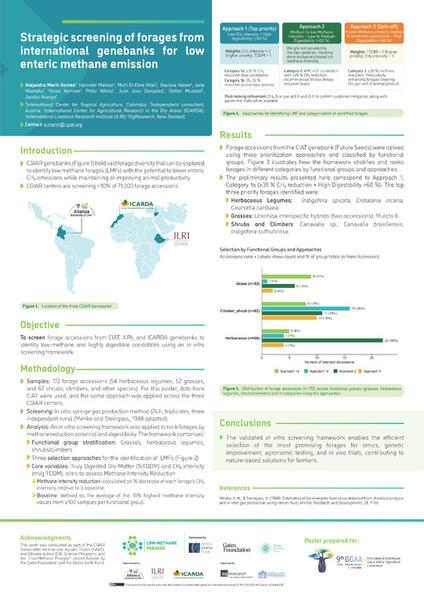
Mitigating methane emissions from ruminant livestock is a key challenge in reducing agricultural greenhouse gas contributions. While numerous strategies have been explored, leveraging plant diversity from global south gene banks presents an untapped opportunity. This study examines the potential of forages from three international gene banks (CIAT, ILRI, and ICARDA) to reduce methane emission while maintaining or enhancing livestock productivity. A total of 172 forage samples representing a wide diversity of species and accessions (categorized as 88 legumes, 28 grasses, 25 browses and 31 others) were evaluated for their effects on rumen fermentation, methane production, and degradability using an in vitro rumen simulation method based on rumen liquor collected from Friesian × Jersey cows, forage samples were incubated for 24 hours. A decision-making tool was developed using Microsoft, Excel Software to evaluate and select forages based on the parameters of interest, which were CH₄ intensity i.e. ml CH₄/g dry matter degraded (DMD) and percent DMD. Forages were ordered from highest to lowest for the parameters of interest. The objective has been to select forages that produced low ml methane/g DMD and high percent DMD. Therefore, as a first step, the average of the highest 10% of the values was taken for the former parameter (these forages are of least interest since they gave the highest values), and values for rest were expressed as percentage of the average. Out of 88 legumes, 15 forages that have the least values for ml methane/g DMD were selected. In the second step, values for the percent DMD were listed against the selected 15 forage samples. Out of these 15 forage samples, promising candidates were identified that had low methane production per unit DMD and high percent DMD. Using this approach the promising forages identified are: Hedysarum carnosum, Hedysarum coronarium, Vicia narbonensis, Trifolium burchellianum, Grona heterocarpa, Centrosema schottii, Codariocalyx gyroides, and Desmodium intortum. For these forages methane production as ml methane/g DMD ranged from 18.4 and 44.4. The average of 10% of the top values for this parameter was 67.6 ± 2.25 (mean ± SD, n = 9), suggesting that the identified forages produce 34.3% to 72.7% lower methane than those that produce high methane per unit DMD. Likewise, percent DMD for the lowest 10% was 47.7±6.76 (mean ± SD, n = 9). For the identified 15 forages, the percent DMD were 87.1% to 101.8% higher compared with the average of 10% of the lowest values for this parameter. The evaluation and ranking, separately of grasses and herbaceous and browse legumes are in progress using the approach. Similarly, acetate/propionate ratio of the samples of least interest (having high methane production per unit DMD) and those of the promising forages identified using the approach is being analyzed. The selected forages form potential candidates for metabolomic profiling to confirm the presence or discovery of anti-methanogenic compounds and in vivo evaluation.

